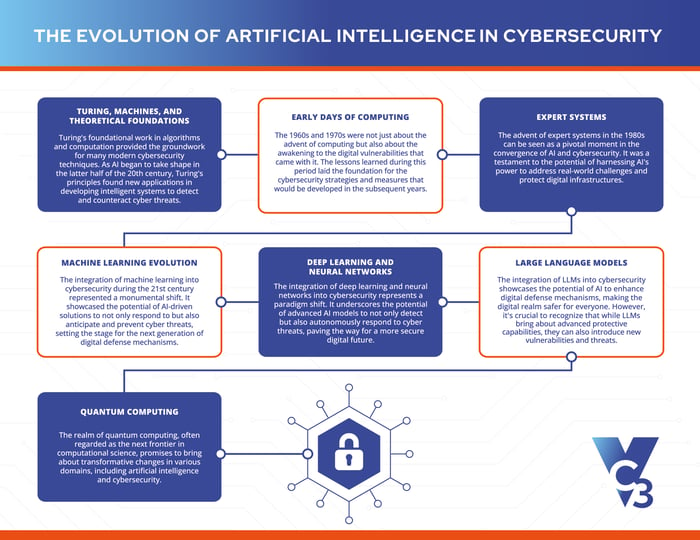In the ever-evolving landscape of technology, few fields have garnered as much attention and intrigue as Artificial Intelligence (AI) and cybersecurity. Their intertwined journey—from the rudimentary prototypes of the past to the sophisticated systems of today—stands as a testament to human ingenuity and adaptability. This symbiotic relationship has consistently remained at the forefront of technology conversations.
The convergence of AI and cybersecurity is not a recent phenomenon. It has deep-rooted historical antecedents that trace back to the early days of computing. As the world began to recognize the transformative potential of computers, it simultaneously grappled with the emerging threats that came with them. This tension underscored the pressing need for automated systems. Systems that could not only detect but also learn and counteract risks and threats.
From the foundational works of pioneers like Alan Turing to the rise of machine learning and quantum computing, the fusion of AI with cybersecurity has been a story of continuous innovation, challenges, and adaptation. As we dive deeper into this narrative, we'll uncover the milestones that have shaped this progression, offering insights into both its past and the promising horizons ahead.

- Turing, Machines, and Theoretical Foundations
- Early Days of Computing
- Expert Systems
- Machine Learning Evolution
- Deep Learning and Neural Networks
- Recent Developments in Large Language Models
- The Emergence of Quantum Computing
- The Journey Continues
Turing, Machines, and Theoretical Foundations
Alan Turing, often referred to as the "father of modern computer science", was a visionary whose work laid the foundation for both theoretical computer science and the field of artificial intelligence. His contributions have had lasting implications, not just in the realm of computation, but also in the intertwined world of AI and cybersecurity.
The Turing Machine
Well before AI or cybersecurity, Turing conceptualized the Turing Machine—a theoretical construct that could simulate any algorithm's logic. This idea was foundational to computer science, providing a framework to understand computational processes and their limitations.
The Turing Test
Turing's exploration into machine intelligence led him to propose the Turing Test, a measure of a machine's ability to exhibit intelligent behavior indistinguishable from that of a human. This was one of the earliest and most influential forays into what would later become the field of artificial intelligence.
Codebreaking and World War II
Turing's brilliance wasn't confined to theoretical realms. During World War II, he played a pivotal role at Bletchley Park, where he and his team developed the Bombe, a machine designed to decrypt the Enigma-encrypted messages of the Nazis. This contribution was instrumental in the Allies' victory, showcasing an early and practical intersection of computation and security.
Legacy in Cybersecurity
Turing's foundational work in algorithms and computation provided the groundwork for many modern cybersecurity techniques. His emphasis on pattern recognition, logical processes, and algorithmic thinking became cornerstones in the development of intrusion detection systems and other cybersecurity tools. As AI began to take shape in the latter half of the 20th century, Turing's principles found new applications in developing intelligent systems to detect and counteract cyber threats.
Early Days of Computing
The 1960s and 1970s marked a transformative period in the world of computing. As computers began to transition from being exclusive tools of academia and large corporations to becoming integral components in business and government operations, new challenges arose.
Pioneering Computers and Their Growing Importance
During this era, mainframe computers dominated the scene. These behemoths, often occupying entire rooms, were the workhorses of large organizations. They managed vast amounts of data, ran complex simulations, and facilitated the early stages of networked communication.
Emergence of the First Computer Viruses
As the utility of computers grew, so did the allure for malicious actors. The first computer viruses emerged during this period. One of the earliest known instances was the "Creeper" virus, which spread through the ARPANET, a precursor to the modern internet. While these initial viruses were primitive by today's standards, they were a clear indication of the vulnerabilities inherent in digital systems.
Response and the Birth of Cybersecurity
Recognizing the potential threats these early viruses posed, the need for dedicated security measures became evident. The concept of cybersecurity, although not yet named as such, began to take shape. Organizations started to develop protocols to safeguard their data. Basic security practices, such as regular data backups and restricted access to computer systems, became more commonplace.
The Broader Implications
These early threats underscored a critical realization: as technology advanced, so would the sophistication of potential threats. The emergence of these initial viruses was not just a technical challenge but a harbinger of the continuous cat-and-mouse game that would define the realm of cybersecurity for decades to come.
These early years were not just about the advent of computing but also about the awakening to the digital vulnerabilities that came with it. The lessons learned during this period laid the foundation for the cybersecurity strategies and measures that would be developed in the subsequent years.
Expert Systems
The 1980s marked a significant shift in the realm of artificial intelligence with the emergence of expert systems. These systems, as the name suggests, were designed to emulate the decision-making abilities of human experts in various fields, from medicine to finance and, notably, cybersecurity.
Foundations of Expert Systems
At their core, expert systems were built upon a knowledge base, which was essentially a vast repository of domain-specific information. This knowledge base was coupled with an inference engine, a component that applied logical rules to the stored information to draw conclusions or make decisions.
Role in Cybersecurity
In the context of cybersecurity, expert systems played a crucial role as early digital guardians. They were designed to monitor network traffic, system activities, and user behaviors, constantly comparing these against a predefined set of patterns or 'signatures' of known threats. The idea was simple yet effective: by knowing what a threat looked like, the system could efficiently identify any anomalies or deviations that might indicate a security breach or vulnerability.
Challenges and Limitations
While expert systems were groundbreaking for their time, they were not without limitations. Their efficacy was largely dependent on the comprehensiveness and accuracy of their knowledge base. If a threat was not previously known or if its signature was not in the system's database, the expert system might fail to detect it. This reactive approach, reliant on known threat patterns, highlighted the need for more proactive and adaptive solutions in the future. This was the early seed for embracing AI-driven security that would later take root.
Legacy and Evolution
Despite their limitations, expert systems laid the groundwork for subsequent advancements in AI-driven cybersecurity. They showcased the potential of using artificial intelligence to enhance digital security measures and set the stage for more sophisticated systems that would emerge in the following decades.
The advent of expert systems during this time can be seen as a pivotal moment in the convergence of AI and cybersecurity. It was a testament to the potential of harnessing AI's power to address real-world challenges and protect digital infrastructures.
Machine Learning Evolution
The early 2000s and 2010s marked a new, transformative period for both artificial intelligence and cybersecurity, with machine learning (ML) emerging as a pivotal force in this transformation.
Data Deluge and the Internet Era
As the internet became ubiquitous, the amount of data generated grew exponentially. Everything from online transactions and social media interactions to IoT devices contributed to this data deluge. While this vast amount of data presented challenges in terms of storage and management, it also offered a treasure trove of information that, if harnessed correctly, could revolutionize threat detection and response.
Adaptive Learning and Anomaly Detection
Traditional security systems often relied on predefined rules and known threat signatures. In contrast, ML algorithms thrived on data. They learned from it, adapting over time. By analyzing vast datasets, these algorithms could establish what 'normal' behavior looked like for a network or system. This baseline then served as a reference point, allowing the algorithms to spot deviations or anomalies that might indicate a security threat.
Natural Language Processing (NLP) and Threat Detection
The introduction of NLP was a game-changer. With NLP, security systems were no longer limited to analyzing code or network traffic. They could now parse and understand vast amounts of text, identifying suspicious patterns or potentially malicious content in emails, forums, and other user-generated content. This added an additional layer of defense, especially against social engineering attacks or phishing attempts.
Predictive Analysis and Proactive Defense
One of the standout features of ML-driven security was its ability to look ahead. By analyzing past incidents, breaches, and attack patterns, ML tools could identify trends and predict potential future threats. This marked a significant shift in cybersecurity strategy. Instead of merely reacting to threats as they occurred, organizations could now anticipate and prepare for them, often neutralizing threats before they could cause harm.
Challenges and the Road Ahead
While ML brought about significant advancements, it wasn't a silver bullet. Challenges like adversarial attacks, where malicious actors fed misleading data to ML models to deceive them, emerged. Even still, the continuous evolution of ML algorithms and techniques promises to address these challenges, ensuring that ML remains at the forefront of cybersecurity innovation.
The integration of machine learning into cybersecurity during this period represented a monumental shift. It showcased the potential of AI-driven solutions to not only respond to but also anticipate and prevent cyber threats, setting the stage for the next generation of digital defense mechanisms.
Deep Learning and Neural Networks
The advent of deep learning and neural networks marked a significant leap in the capabilities of AI-driven cybersecurity solutions. These advanced models, inspired by the structure and function of the human brain, brought a new level of sophistication to threat detection and response.
Convolutional Neural Networks (CNNs)
CNNs, a class of deep neural networks, are primarily known for their prowess in image and pattern recognition. In the context of cybersecurity, their application extends beyond images alone. Phishing attacks, where malicious actors attempt to deceive individuals into revealing sensitive information, often involve skillfully crafted emails that mimic genuine communications. CNNs, with their ability to analyze intricate patterns, could dissect the subtle nuances of email structures, differentiating between legitimate emails and potential phishing attempts. This added a robust layer of defense against one of the most prevalent cyber threats.
Recurrent Neural Networks (RNNs)
RNNs are designed to recognize sequences and patterns in data, making them particularly suited for tasks that involve sequential data analysis. In cybersecurity, RNNs are used to monitor user behavior. By analyzing sequences of user actions, RNNs could establish typical behavior patterns. Any deviation from these patterns, such as an employee accessing sensitive data at unusual hours, would be flagged as suspicious. This continuous monitoring ensured that potential threats were identified in real-time.
Autonomous Response Mechanisms
One of the most transformative advancements brought about by deep learning in cybersecurity was the ability to autonomously respond to threats. Traditional security systems would typically alert human administrators when a potential threat was detected. However, with the speed and scale of modern cyberattacks, waiting for human intervention could result in significant damages. Deep learning models, equipped with autonomous response mechanisms, could take immediate preventive actions upon detecting a threat. This could range from shutting down compromised nodes to isolating malicious entities, ensuring that potential damages were minimized.
Challenges and Future Prospects
While deep learning and neural networks have undeniably enhanced cybersecurity capabilities, they are not without challenges. Adversarial attacks, where malicious actors design inputs to deceive neural networks, are a growing concern. The research community is actively working on countermeasures, and the continuous evolution of these models promises to address existing vulnerabilities.
The integration of deep learning and neural networks into cybersecurity represents a paradigm shift. It underscores the potential of advanced AI models to not only detect but also autonomously respond to cyber threats, paving the way for a more secure digital future.
Recent Developments in Large Language Models
The rapid advancements in artificial intelligence have given rise to a new generation of models known as Large Language Models (LLMs), with ChatGPT being a prime example. These models, characterized by their vast parameters and ability to process and generate human-like text, have garnered significant attention in the AI community and beyond.
Unprecedented Capabilities
LLMs, due to their extensive training on diverse datasets, possess a vast reservoir of knowledge. This allows them to understand context, generate coherent responses, and even craft entire articles or reports. Their capabilities extend far beyond simple text generation, making them invaluable assets in various contexts.
Role in Threat Intelligence
In the realm of cybersecurity, LLMs have found a niche in threat intelligence. The digital world is awash with textual data, from logs and alerts to forums discussing the latest vulnerabilities. LLMs can sift through this sea of information, identifying patterns, potential threats, and even zero-day vulnerabilities. Their ability to analyze and summarize vast amounts of data in real-time provides cybersecurity experts with actionable insights, enabling quicker responses to emerging threats.
Training and Awareness
One of the challenges in cybersecurity is ensuring that individuals, whether they are employees in an organization or the general public, are aware of potential threats and best practices. LLMs, with their interactive capabilities, are revolutionizing cybersecurity training. Instead of static presentations or documents, users can now engage with models like ChatGPT in real-time Q&A sessions, simulations, and even mock phishing attempts. This interactive approach ensures better retention of information and prepares individuals for real-world scenarios.
However, it's essential to exercise caution when relying on these models. LLMs are known to produce 'hallucinations', which refer to instances where the model might generate information that isn't accurate or doesn't align with real-world facts. Always ensure that any information or advice obtained from ChatGPT or other LLMs is cross-referenced and verified for accuracy and relevance.
Challenges and Ethical Considerations
While LLMs offer numerous benefits, they are not without challenges. Their ability to generate human-like text can be exploited for malicious purposes, such as crafting convincing phishing emails or spreading misinformation. Moreover, there are ethical considerations regarding their use, especially when it comes to data privacy and potential biases in their responses. The AI community is actively addressing these challenges, ensuring that LLMs are used responsibly and ethically.
The emergence of Large Language Models like ChatGPT represents a significant milestone in the AI journey. Their integration into cybersecurity showcases the potential of AI to enhance digital defense mechanisms, making the digital realm safer for everyone. However, it's crucial to recognize that while LLMs bring about advanced protective capabilities, they can also introduce new vulnerabilities and threats. In the hands of malicious actors, these models could be exploited, underscoring the need for continuous vigilance and adaptive strategies in the ever-evolving cybersecurity landscape.
The Emergence of Quantum Computing
The realm of quantum computing, often regarded as the next frontier in computational science, promises to bring about transformative changes in various domains, including artificial intelligence and cybersecurity.
The Quantum Advantage
At its core, quantum computing leverages the principles of quantum mechanics to perform computations. Unlike classical computers, which use bits (0s and 1s) to process information, quantum computers use quantum bits or qubits. These qubits can exist in a superposition of states, allowing quantum computers to process vast amounts of information simultaneously. This inherent parallelism gives quantum computers a potential edge, enabling them to solve problems deemed intractable for classical computers.
Implications for Encryption
One of the cornerstones of modern cybersecurity is encryption, which ensures that data remains confidential and secure. Many encryption algorithms rely on the difficulty of certain mathematical problems, like factoring large numbers. With the advent of quantum computers, algorithms such as Shor's can factorize these numbers in polynomial time, potentially rendering traditional encryption methods obsolete. This poses a significant challenge, as much of the world's digital communication relies on these encryption standards.
Quantum-Resistant Cryptography
Recognizing the potential threat posed by quantum computing, researchers and cryptographers are delving into the development of quantum-resistant cryptographic methods. These algorithms are designed to be secure against the potential capabilities of quantum computers, ensuring that encrypted data remains safe even in a post-quantum world.
Quantum AI and Cybersecurity Solutions
On a more optimistic note, the power of quantum computing can be harnessed to enhance AI-driven cybersecurity solutions. Quantum-powered AI models, with their ability to process and analyze data at unprecedented speeds, could revolutionize threat detection, real-time analysis, and response mechanisms. These models could sift through vast datasets in real-time, identifying patterns and threats that might be missed by “classic” AI models.
The Road Ahead
While the full potential of quantum computing is yet to be realized, its implications for AI and cybersecurity are profound. As research progresses, it will be crucial for organizations, governments, and individuals to stay abreast of developments, adapting and evolving their cybersecurity strategies to harness the benefits of quantum computing while mitigating its potential risks.
The intersection of quantum computing with AI and cybersecurity promises to reshape the digital landscape, offering both challenges and opportunities that will define the future of digital security.
The Journey Continues
The evolution of Artificial Intelligence and cybersecurity represents a paradigm shift in the technological landscape.
The integration of AI into cybersecurity has undeniably augmented our defense mechanisms, offering unparalleled capabilities in threat detection, predictive analytics, and real-time response. However, this advancement is not without its complexities. The dual-use nature of AI—its potential for both protection and exploitation—demands rigorous oversight and ethical considerations.
In navigating this intricate domain, a balanced approach is imperative. It is essential to harness the capabilities of AI judiciously, ensuring that its deployment in cybersecurity aligns with ethical standards, regulatory frameworks, and best practices. As the digital landscape continues to evolve, a proactive, informed, and strategic approach will be pivotal in leveraging AI's potential while safeguarding against its inherent risks.





